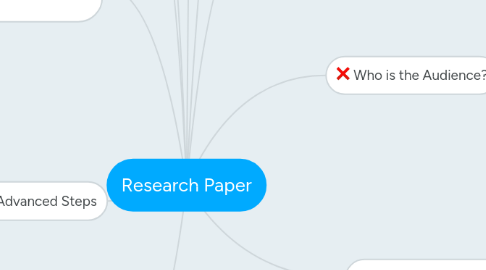Research Paper
von Kevin Castillo


1. Kleins' Caveat
1.1. No single style works for everyone!
1.2. Try finding one that suites your learning style
2. Basic Steps
2.1. Read Abstract
2.2. Read Introduction
2.3. Reade Conclusion
2.4. Skim Important Details
3. Advanced Steps
3.1. Does the argument make sense? If so, what was the evidence, details, or supporting factors that helped create the conclusion. (Take your time and analyze the text)
3.2. Compare and contrast similar documents and find key details that are prevalent in each text. Skim through some related content to better grasp the text's meaning and overall argument.
3.3. Implement web pages (Google Scholar, RefWorks, or other reputable cites) to find sources and information that is credible and relevant to the text.
3.3.1. Important to do background checking to grasp the bigger picture and relate to the text. Don't come in blind or you will not find the answers you are looking for.
4. Other Alternatives
4.1. Get a much better idea of what an article is about by reading the works cited section.
4.2. Encyclopedia — there are lots of Handbooks, Companions, and Encyclopedias in most academic areas. See what an expert in your field thinks of the article (or theory or construct or whatever) in question. Forward citation searches can help too — see what other people said about your article when they cited it.
5. Go back and read the paper quickly, skip over the images or charts
5.1. Now, go back and read the article carefully. Pay attention to each section or areas that seem important
6. Writing a Research Paper
6.1. Make a prayer to St. PIE
6.1.1. 1. Make a STAND
6.1.2. 2. Back it up with PROOF
6.1.3. 3. Followed by INFORMATION
6.1.4. 4. Finished with EVIDENCE
7. Genre
7.1. This section will provide the difference between analytical and argumentative research paper
7.2. Argumentative: consists of clear introduction and informs the audience of the topics they will discuss. Providing evidence on a controversial or debatable topic to persuade the reader into agree or disagreeing
7.3. Analytical (analysis): consists of a question and answering style of writing. A question or topic is proposed and the writer provides evidence to support the chosen topic
8. Selecting Topics
8.1. Guide the reader through the process of choosing topics
8.2. Brainstorming is often a successful way for students to get some of these ideas down on paper
8.2.1. It consists of a timed writing session during which the student jots down—often in list or bulleted form—any ideas that come to his mind.
8.3. Research topics are often fluid, and dictated more by the student's ongoing research than by the original chosen topic
9. Who is the Audience?
9.1. Which tone, style, or method to convey your message depends on the audience of the paper
9.1.1. Try to imagine an audience that would be interested in and benefit from your research
9.2. The instructor should be considered only one member of the paper's audience
10. Cheat Or Not To Cheat?
10.1. In your writing, you must give credit whenever you use information that you found in a source, unless it is common knowledge
10.2. Paraphrased information
10.2.1. Summarized information
10.2.1.1. Facts that are not common knowledge
10.2.1.1.1. Ideas, including opinions and thoughts about what particular facts mean
